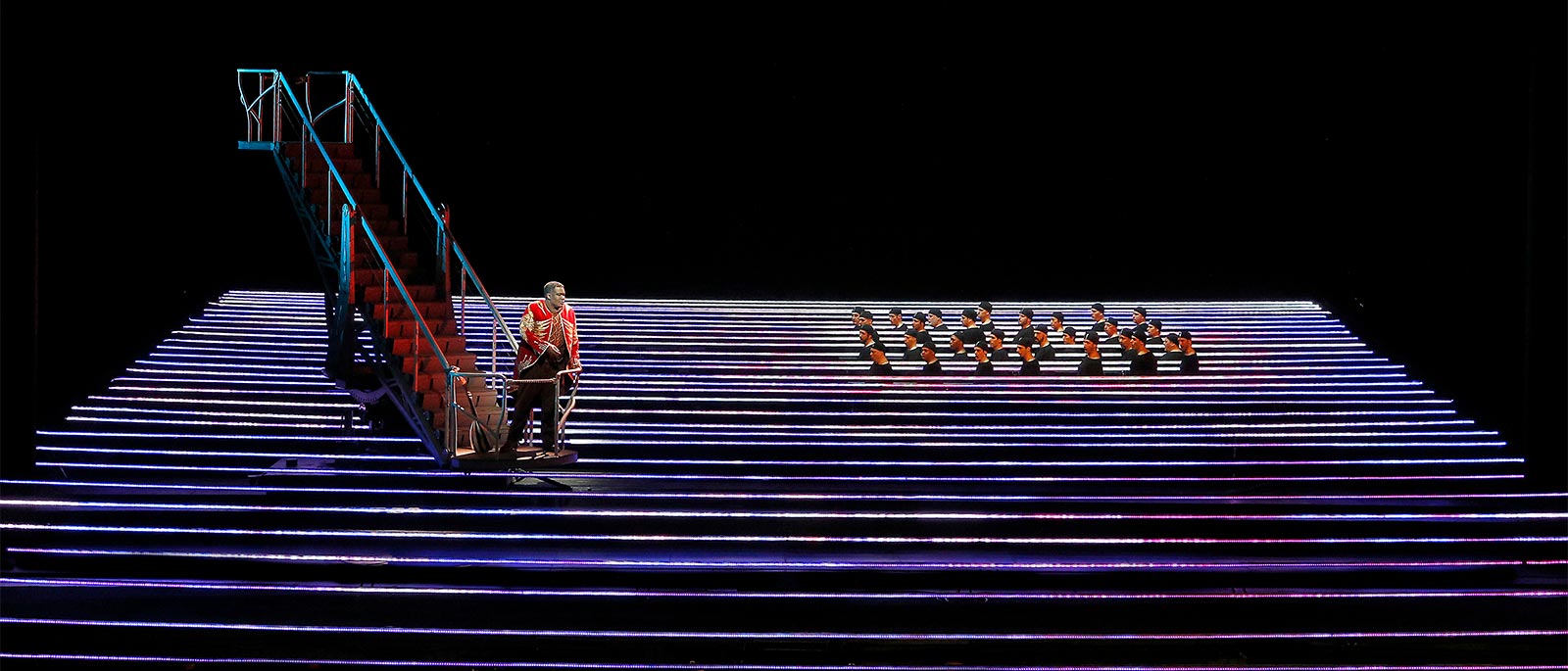
Sea of Lights
The Met-premiere production of L’Amour de Loin, directed by Robert Lepage, features breathtaking visuals by set and costume designer Michael Curry. Before the opera opened, Curry sat down with the Met’s Jay Goodwin to discuss his dazzling approach to design.
Your work includes puppet design, set design, costume design, lighting design— almost everything that contributes to the visual impact of theatrical performance. How did you end up working in such a broad range of technical fields?
I’m eternally curious. I started as a painter and sculptor who needed to know how things worked. I was the sort of painter who wanted to know how ancient painters made their pigments, for example. So when I was in college, I was grinding my own pigments from natural elements found in the woods. And in sculpture, I was impatient and started experimenting with more modern materials. While my professors wanted me to carve in stone and wood, I was interested in polystyrene and fiberglass and carbon fiber. I believe that if Michelangelo were alive today, he’d be rocking computer-assisted design and robotic sculpture and all the things that we do. So, while in American theater there tends to be a lighting designer, a projection designer, a content designer, and so on, I follow more of the European model that one designer will do costumes, lighting, sets, sometimes even direction. It allows you to have better control, and more of your ideas end up on stage intact.
You’ve worked in so many different genres of theater—Broadway, Cirque du Soleil, the Olympics, the Super Bowl, Katy Perry concerts ... What makes opera unique?
Opera’s one of my favorite forms. It’s amazing because the visual designers are actually offered the broadest range of latitude. There is expression in interpretation from the conductor and the orchestra, but the music itself is written in stone. What is not written in stone is the way the piece looks, the look of the sound. And so it’s very important for me that the visuals “hear” the music. This is why visual design in opera is often so provocative. It’s the one tool that you can use to expand on the solidity of the music—to a fault, sometimes. I am pretty disciplined about supporting the music and allowing my set and costumes to become a character—letting my ego stay out of the way of the music.
It’s rare in opera to work with a living composer. But Kaija Saariaho is here and very involved in the new production of L’Amour de Loin.
I have to tell you how wonderful it is to realize that the composer’s sitting in front of me, and it’s not a plaster bust. It’s intimidating, but she is so warm that it’s been very comfortable. She has talked about how the music needs space, and that the reason she was intrigued by the notion of the sea was that her music has so many textures, and the ocean is a wonderful metaphor for allowing them to emerge—a vessel of opportunity and vastness for the largeness of the music. There are both longshots and really intimate close-ups that are established aurally.
You are both set and costume designer for this production. Could you talk a bit about your visual approach—especially to representing the Mediterranean Sea, which must be seen on stage?
It’s a fantastic opportunity to find a unique way to show a whole ocean. How does one show an ocean that is in every scene, and not make it boring? How can the sea hear the music and tell the story? So I started with the music, which is filled with light. One thing I find fascinating is gazing across the sea. It’s the simplest thing in the world—a flat ocean with light reflecting on it, but it seems to mesmerize people and put them in a poetic, romantic, sometimes dark place. Robert Lepage and I agreed that the sparkle of water on a vast, simple surface would be very important. And then I was inspired by a metaphor of music—the strings of a piano or a harp. I knew that horizontal lines would convey a sense of the ocean very well, and would also allow necessary avenues for conveyance across the sea from left to right. And to make our horizontal lines sparkle and shimmer, we use narrow strips of LED lights. Of course, the sea must move, so we stretched the whole thing on a loom that we can twist and change like the rolling sea. I also wanted it to feel immersive to the audience, so a very important and provocative thing we’ve done is to extend the sea over the orchestra pit, as if it comes right down into the audience, connecting them with the body of the music. In all, we have 90,000 points of light, individually changeable to any one of millions of colors. We use this as an ephemeral expression of music—as a voice, if you will. Then, to present the singers, I developed this idea of a bridge—two presentation platforms separated by a span that shifts between a stair and a ramp—which can move laterally and also rotate. It’s a big mechanical device—a beautiful, silent, many-ton piece of equipment driven by extraordinary computer-controlled motors, which moves like a dancer. I consider it a dancer in the show.
At the Met, we have an army of craftsmen and technical and theatrical staff to help realize all of these wonderful ideas. What is it like to work with them?
Because I’m such a technical guy, I know what the skill level at the Met is. They represent the best expression of these skills. Not enough attention is given to the amazing artisanry and discipline of these extraordinary people. Some of these things are almost forgotten skills, but they aren’t forgotten here. The costumes are a great example, too. Every stitch of costuming has been built here, and they are beautiful.
Jay Goodwin is the Met’s Editorial Director.